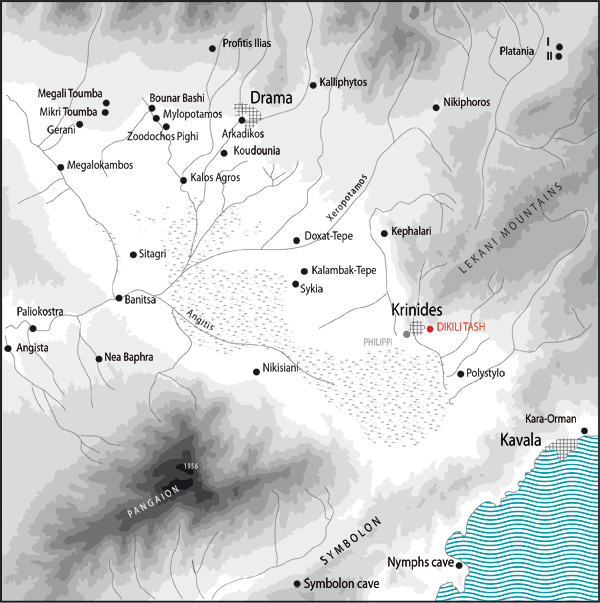Neolithic period: The natural environment
 The geographical entity today made up of the plains of Drama and Serres appeared during the Miocene as a result of successive collapses brought on by faults. Subsidence developed separately in the two plains, causing a land partition of Tertiary sediments to appear between them.
The geographical entity today made up of the plains of Drama and Serres appeared during the Miocene as a result of successive collapses brought on by faults. Subsidence developed separately in the two plains, causing a land partition of Tertiary sediments to appear between them.
From then on, most of the Drama plain has been occupied by a marsh whose centre was transformed into a lake during the wettest periods. Huge quantities of pit and lignite accumulated in it.
During the Pleistocene, orrential watercourses carried down substantial alluvial deposits that formed alluvial fans at the base of the mountains.
In the Holocene period, the extent of the marsh diminished, but the pit-field underneath continued to develop: pit deposits thus reach a thickness of c. 200 m. Slight sedimentation affected the central part of the plain. The main features of the modern landscape were thus established.
The plain measures 50 x 15 km and is oriented Northwest-Southeast. Surrounded as it is by mountains on all sides, it forms a rather closed entity, whose hypsometer lies between 45 and 80 meters above sea level in the centre and up to 200 m on the alluvial cones. The marsh occupied the lowest parts of this area until its drainage in the early 20th century.
The edges of the plain, i.e., the part between the mountains and the marsh, were most advantageous for human settlement: they offered land for cultivation, abundant drinking water, and access to a variety of environments rich in natural resources of all kinds. This is where Neolithic settlements were founded: Sitagri to the Northwest, Sykia, Kalambak-Tepe, Doxat-Tepe and Kephalari to the East, Polystylo and Dikili Tash to the Southeast, and others. The local environmental conditions differed slightly from one settlement to the other, however: Sitagri was next to running water (Angitis river), whereas Doxat-Tepe and Kalambak-Tepe were founded at the lowest part of a big alluvial fan and very close to the marsh, i.e., in a rather humid zone, like Dikili Tash. On the contrary, Xeropotamos (Prophitis Elias) was situated directly at base of the mountains and was thus in a much drier environment.
Forests, which advanced across the landscape in the post-glacial period when the climate became warmer, were still common during the Neolithic, with deciduous oaks being the dominant species. It seems that some clearing took place around the settlements, but the extent of this should not be overestimated. Indeed, analysis of faunal remains indicates a strong presence of wild species living in forests (deer, roe, rodents).

